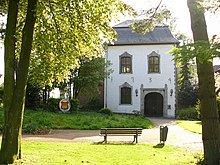Odenkirchen Castle
| Odenkirchen Castle | ||
|---|---|---|
|
Burg und Herrlichkeit Odenkirchen from the northwest around 1680, painting by Gebhard Schwermer |
||
| Creation time : | First mentioned in 1153 | |
| Castle type : | Niederungsburg, location | |
| Conservation status: | Castle tower (1734) | |
| Standing position : | Local nobility | |
| Place: | Mönchengladbach - Odenkirchen | |
| Geographical location | 51 ° 8 '1.8 " N , 6 ° 27' 0.1" E | |
| Height: | 53 m above sea level NN | |
|
|
||
The castle Odenkirchen was a castle in the Mönchengladbach District Odenkirchen in North Rhine-Westphalia .
The settlement of Odenkirchen, which began in the 12th century at the latest, began at the castle of the Lords of Odenkirchen. The first system consisted of a wooden castle, which was built on an embankment ( Motte ) in a water and swamp area. Gradually the change to a massive stone castle took place in the following centuries.
The castle was first Odenkirchen 1153 in a charter of King Frederick Barbarossa mentioned in this Cologne Archbishop Arnold II. , That the Cologne archbishopric confirmed the ownership of the castle Odenkirchen. Odenkirchen was an independent subordinate of the Cologne Archbishopric. Such a subordination was also called "glory".
In 1689 the castle and chancellery were cremated by bombardment during the Franco-Dutch War . In 1701, the fire in Odenkirchen followed, which laid the castle complex and the entire village to rubble and ashes. The castle was never rebuilt in its old state. In 1734, the von Merode-Westerloo family had the still standing archway renewed and the buildings that were used to manage the extensive land were rebuilt.
Lengthy processes for the award of the castle had devoured more than 300,000 Reichstaler and totally shattered the finances of those from Merode. In 1730 they had to pledge the castle to the Dutch diplomat and composer Count Unico von Wassenaer for 64,968 Reichstaler. When the von Merode family was later unable to repay the pledge, Johann Wilhelm Augustin, Count of Merode, ceded his rights to Odenkirchen to Unico von Wassenaer. He sold the castle in 1745 for 94,000 Reichstaler to the Cologne elector and Archbishop Clemens August . He used bailiffs for the administration of Odenkirchen . The last bailiffs were the court chamber councilor Klemens August Bernhard von Bouget from Aachen , who also acted as tenant of the Zoppenbroich house , and his son-in-law Christian Joseph Aldenhoven from Zons .
In 1789 the French Revolution broke out and the revolutionary army also occupied Odenkirchen. In the course of secularization , all church goods were confiscated. The castle was sold: In 1803 Benedicta von Bouget acquired the castle with all of the land and sold it in 1811 to the merchant Jean Lüttringhausen from Elberfeld. In 1872 it became the property of the Odenkirchener Burgverein; In 1920 it was acquired by the Catholic parish of St. Laurentius.
The west wing of the castle along Hoemenstrasse was demolished at the end of the 19th century, and the remaining building was destroyed by bombs in 1943. The burnt out castle tower was restored in 1950/51. The Heimatverein Odenkirchen took over the building in 1988 from the parish of St. Laurentius with the condition of restoration for 30 years on a long lease . This lease exists to this day and relates to all rooms in the castle with the exception of the two lower rooms, which were made available to the altar servers by the parish. They prepared the rooms in vigorous self-work. Here, the leaders of the altar boys have the opportunity to meet at the weekend or hold their meetings and look after the rooms as well as the anteroom with the archway and the castle garden.
literature
- Robert Prößler: The Archbishopric of Cologne in the time of Archbishop Konrad von Hochstaden. Organizational and economic basics in the years 1238-1261 , Janus Verlag, ISBN 978-3922977490


